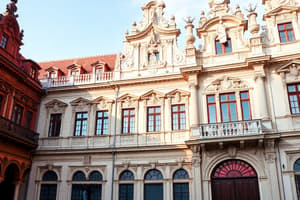Podcast
Questions and Answers
What characteristic distinguishes English landscape gardens like Castle Howard?
What characteristic distinguishes English landscape gardens like Castle Howard?
- Natural forms that hide human intervention (correct)
- Symmetrical design with defined geometric shapes
- Strictly formal pathways guiding visitors
- Use of heavy ornamental elements in landscaping
How does the design of Palazzo Barberini enhance privacy in its architecture?
How does the design of Palazzo Barberini enhance privacy in its architecture?
- By incorporating large open spaces throughout
- Through an U-shaped plan with aligned doorways (correct)
- By using numerous balcony areas for visibility
- By featuring a single large communal hall
What major innovation is attributed to the design of San Carlo alle Quattro Fontane by Francesco Borromini?
What major innovation is attributed to the design of San Carlo alle Quattro Fontane by Francesco Borromini?
- Focus solely on aesthetic appeal
- Use of traditional symmetrical forms
- Manipulation of geometry and light (correct)
- Strict adherence to classical styles
In what way did the Baroque architecture of Versailles symbolize royal authority?
In what way did the Baroque architecture of Versailles symbolize royal authority?
What purpose did the oval colonnades of Piazza San Pietro serve during the Counter-Reformation?
What purpose did the oval colonnades of Piazza San Pietro serve during the Counter-Reformation?
What does the design of the Stadhuis in Amsterdam represent during the Dutch Republic’s Golden Age?
What does the design of the Stadhuis in Amsterdam represent during the Dutch Republic’s Golden Age?
According to the thematic essay, how did Baroque architecture influence statecraft?
According to the thematic essay, how did Baroque architecture influence statecraft?
Which of the following best describes Ballon’s view of architecture?
Which of the following best describes Ballon’s view of architecture?
Flashcards
Baroque Architecture
Baroque Architecture
A style of architecture that emerged in the 17th century, characterized by grandeur, drama, and elaborate ornamentation. It often employed classical elements but with a greater emphasis on movement, illusion, and theatricality.
English Landscape Garden
English Landscape Garden
A style of landscape design popular in England during the 18th century, emphasizing natural forms and a sense of untamed beauty.
Statecraft Architecture
Statecraft Architecture
A type of architecture that aimed to display and reinforce the power and authority of the state.
Versailles: Royal Absolutism
Versailles: Royal Absolutism
Signup and view all the flashcards
Piazza San Pietro: Religious Unity
Piazza San Pietro: Religious Unity
Signup and view all the flashcards
Stadhuis: Republican Ideals
Stadhuis: Republican Ideals
Signup and view all the flashcards
Architecture as a Tool of State
Architecture as a Tool of State
Signup and view all the flashcards
Study Notes
Castle Howard
- Natural landscape, English landscape garden style
- Natural forms, hides human intervention, appears untouched
- Building landmark: Temple of Four Winds. Cubic form inspired by the Villa Rotunda
Palazzo Barberini
- U-shaped plan
- All doorways aligned
- Rooms become more private further in
Collège des Quatre Nations
- Baroque with classical elements
- Domed temple front church with curved wings
San Carlo alle Quattro Fontane
- Designed by Francesco Borromini in 17th-century Rome
- Blends creativity and practicality through geometry, light, fluid movement
- Challenges static conventions, design as evolving & context-driven
- Encourages experimentation, functional & aligns with modern needs (sustainability, social equity)
- Creativity and practicality are not mutually exclusive; architecture inspires while addressing needs
Baroque Architecture and Statecraft
- Baroque architecture and landscape design were tools of statecraft. Projected authority, legitimacy, and control.
- Versailles (phases 1 & 2): Designed by Louis Le Vau & Jules-Hardouin Mansart, gardens by André Le Nôtre. Symbolized Louis XIV's absolute authority by scale, hierarchy, & spatial design (king's bedroom center). Gardens reinforced control over nature, embodying dominance.
- Piazza San Pietro: Designed by Gian Lorenzo Bernini during the Counter-Reformation. Oval colonnades symbolize church’s welcoming arms, guiding pilgrims to St. Peter's Basilica. Emphasized divine authority, unity, and strength during political/religious upheaval.
- Stadhuis (Amsterdam): Designed by Jacob van Campen during the Dutch Republic's Golden Age. Symbolized civic pride, republican governance, classical Roman ideals of order and stability. Positioned as trade/political center highlighting democratic values.
- Baroque architecture transcended aesthetics to shape power and control perceptions. Demonstrated royal absolutism (Versailles), religious unity (Piazza San Pietro), and republican ideals (Stadhuis).
- Architecture transforms political agendas into enduring symbols of authority (Ballon's argument).
Studying That Suits You
Use AI to generate personalized quizzes and flashcards to suit your learning preferences.




